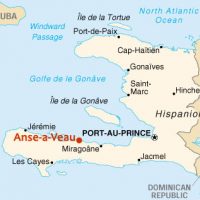Anse-A-Veau

The City of Anse-à-Veau was founded in 1721 and raised to the rank of commune in the same year. There are seven communal sections. The dominant terrain of the commune is the plain and its climate is normal. The inhabitants of this commune are called Anse-Velais. The total population of Anse-à-Veau in 1998 was 37,414 inhabitants with a density of 52 per sq mile (137 inhabitants/km2). In the year 2004, it had a little less than 38 000 inhabitants. In 2015, 34,613.
Neighborhoods
Ville de L’anse à Veau
1ère Section Baconnois
Section de Bouzi
5eme Section Cocoyers (Duchène)
6eme Section Grande Rivière
7eme Section Saut De Baril
Section de Anaud
Migration: Following Haiti’s magnitude 7.0 2010 earthquake, which reduced most of Haiti to rubble, thousands upon thousands of Port-au-Prince survivors overflowed Anse-à-Veau, severely straining its people and services.
Economy: In the field of economic and financial infrastructures, the municipality has inventoried: a credit union, a restaurant, a representative of the DGI (Tax office) and some banks. There are no open ports in the town of Anse à Veau.
Anse-à-Veau’s main income-producing activities are agriculture, livestock, and fishing. Farmlands produce coffee, sugarcane, lemons, and oranges, and use sustainability practices. Cotton-growing also takes place. The small-craft fishing industry plies its trade along Anse-à-Veau’s coastline.
Trade is also among the main activities of L’Anse à Veau. The inhabitants of the town trade mainly with Miragoâne and Port-au-Prince.
Infrastructure: The town suffers from the same infrastructure weakness as many small communities do in Haiti. Its road system is so run-down as to be nearly impossible to drive on. The majority of them remain unpaved, and people complain incessantly about their tires wearing out too quickly. But road projects are being started by a non-government organization, American Haitian Foundation (AHF). AHF is also involved in building schools and churches, and they have implemented a school lunch program for primary- school children.
Transportation: Anse-à-Veau has no airport, so travelers must drive to Les Cayes Airport, the closest one to the town. Further away are Perry Municipal Airport and Port-au-Prince International Airport.
Education: The Ministry of the National education of Youth and Sports is represented in the municipality by the school district office of Anse-à-Veau. This commune has no kindergarten. It has several primary schools, some of which public and more are private. At the secondary level are counted three schools, including one public and two private. On the other hand, the municipality does not have technical and vocational schools or Literacy centers, university, or other higher schools.
Health: The Ministry of Public Health is not represented in the town of Anse-à-Veau . One hospital and one clinic were identified with one doctor and one trainee dentist, two nurses, seven auxiliary and thirty six certified matrons.
Utilities: Regarding water potential, the town has seven rivers, a few public fountains, and dozens of springs. Only the city of Anse-à-Veau is electrified by an electric motor managed by the town hall.
Security: In terms of administrative and judicial infrastructure, the commune has a police station with a total of nineteen police officers, a court of the peace, a civil court, a prison and a civil registry office.
Religion: The town of L’Anse à Veau has eleven Catholic churches (including chapels), ten Baptist churches, four Adventist churches and six Halls of the Kingdom of Jehovah’s Witnesses. The town of Anse-à-Veau does not have an NGO or an international organization. Only one political party is found there.
Communication: In addition, it has a telephone call center that only contains a booth. There is no post office, no radio, television station, nor newspaper / magazine in this municipality.
Leisure: With regard to leisure, the town is very poorly endowed. There is no library, museum, theater or cinema. Football (soccer) is the only sport practiced in the municipality. Twenty gagueres were also listed.
Heritage: In terms of cultural heritage, the town has a fort (Fort Jn Jacques Acao) which is located in k-Jolie (Grande Rivière) and two notorious temples where animals are sacrificed and Vodun ceremonies are organized.

